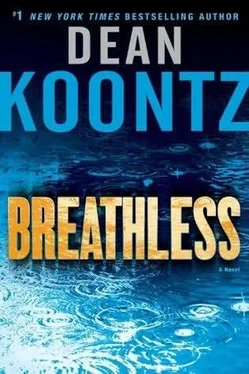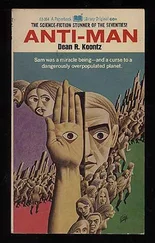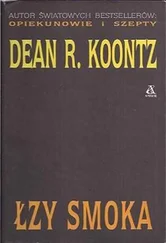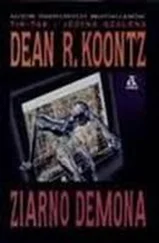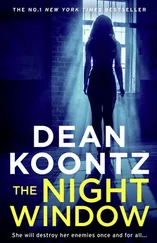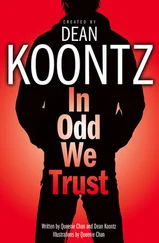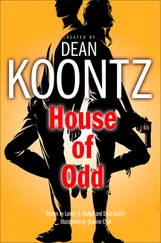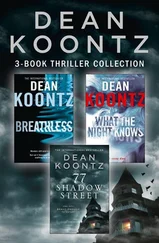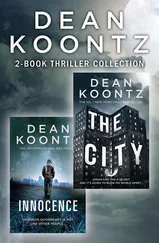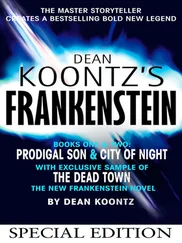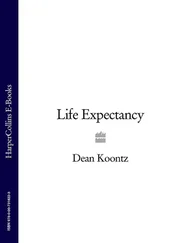Another reason that he killed no more than two people a year was because he only killed people whom he found attractive, and very few people met his standards.
There were guys who could do any halfway-appealing woman they met. Rudy would never be one of them. They were transgressing on the installment plan, rebelling against moral order in a tedious series of minor skirmishes. By contrast, Rudy launched only powerful and profound attacks.
After arriving by executive helicopter at the site, logging in, and signing nondisclosure agreements customized to the unusual nature of this incident, Lamar Woolsey and Simon Northcott were presented with laminated holographic photo-ID cards on lengths of cord, which they had to wear around their necks at all times.
Following an in-depth background presentation on the situation, they were told where to find Specimen 1 and Specimen 2. Already, the names given to them by the veterinarian, Camillia Rivers, were being used by both the uniformed security agents and the Homeland Security bureaucrats: Puzzle and Riddle.
The animals were confined in an inflatable tent in the backyard, only steps from the line of four mobile laboratories. Blood, urine, and other tissue samples would be collected here and taken to the labs. When needed for an MRI or other test, the animals would be conveyed to the laboratory containing that specific equipment. By keeping Puzzle and Riddle primarily in a structure accessible to the personnel in all four labs, several scientists could observe and examine them at the same time.
The twenty-foot-square tent had been anchored to forty pitons. Each eighteen-inch-long piton measured an inch in diameter and had been driven into the earth with a pneumatic hammer.
Access to the tent was through an uninflated flap, next to which stood an armed agent. They flashed their photo ID and went inside.
Interlocking panels of tight plastic grid made a stable floor. Four free-standing racks of adjustable lamps provided illumination.
A nine-foot-long, seven-foot-wide, four-foot-high platform occupied the center of the tent. The platform held an eight-by-six steel cage that the Colorado crisis-response team acquired somehow before leaving their home base in Colorado Springs.
In the cage were a bowl of water, a dog bed-and two creatures who were inexpressibly more beautiful than the photos of them that Lamar had seen during the background briefing. They came at once to the wall of the cage and reached out entreatingly, between the bars, with their small black hands.
The sight of them affected Simon Northcott as nothing and no one ever had before: He was stunned silent.
As Lamar approached the cage, he reached out to hold one hand of Puzzle’s, one of Riddle’s.
The feeling that came over him must have been different from the one that rendered Northcott speechless, for he would have ranted his enchantment in whatever humble poetic language he could summon-if anyone had been present who would understand this most human of all yearnings for mystery and meaning.
These animals had about them an aura of innocence and purity that he found almost palpable, that he had never before encountered nor imagined he ever would. He approached them rapt with wonder, but then found himself surrendering to an unexpected veneration for which he had no explanation. He came to tears.
Moving slowly around the cage, intently studying the animals and oblivious to Lamar’s emotion, Northcott broke his uncharacteristic silence and spoke of things that didn’t matter, of things that Lamar could not compute.
When at last Lamar could speak, he said, “Their eyes. Isn’t it ironic, Northcott, that perhaps the principal challenge they offer you is the impossible nature of their eyes?”
Northcott understood his reference and was not pleased.
On the kitchen table stood a two-foot-square multilayered pane of sandwiched glass, held in a steel frame between two three-inch-diameter steel cylinders. Red light shown within a penny-size hole near the top of each cylinder. The device plugged into a wall outlet but also into Paul Jardine’s laptop.
Cammy had been told that lasers scanned her eyes for responses of the irises, recording a continuous measurement of the dilation of her pupils, which assisted in determining the truthfulness of her answers because the pupil involuntarily opened wider when a lie was told. Other changes in the eye, unspecified by Jardine, were also evidently analyzed.
At the start of the session, the lasers also mapped her face as expressionless as she could make it. Thereafter, a continuous record of her facial topography detected the subtlest nuances of expression that researchers had found to be associated with either truth-telling or prevarication.
This laser polygraph had been developed exclusively for Homeland Security. Jardine used it in conjunction with a tightly fitted glove woven full of electronic sensors that measured changes in the body activities that were of interest to more traditional polygraphers: pulse, blood pressure, perspiration.
Before being subjected to the session, she had been provided with a statement signed by Jardine in the presence of a witness, stating that no information obtained herein could be used against her in any court of law and that she was immune from prosecution for any matters touched upon by his questions and her replies.
“We are more determined to get the full truth of all this than we are interested in prosecuting anyone for anything,” Jardine had said.
On the other hand, once she had been granted immunity, if she still declined to be polygraphed, she could be prosecuted under two statutes that, upon conviction, allowed for consecutive sentences totaling as much as four years in prison.
When Cammy had still hesitated, Jardine said, “Look at it this way. If you want to lie your head off, you can do so with no fear of punishment. You’ve got immunity. But if you lie, it’s still worth my time to conduct this debriefing, because I’ll see when you’re lying and I’ll have some hope of deducing why.”
“I have no intention of lying to you.”
“By the time we’ve gotten this far,” Jardine had said, “no one ever intends to lie.”
Now, an hour into the interrogation-which Jardine insisted on calling a debriefing-the blinds were closed over the kitchen window and door. Light came only from the soffit lamp over the sink and the screen of the deputy director’s laptop.
Cammy couldn’t see the low-intensity lasers. They were of a single specific wavelength of light or a narrow band of wavelengths, and all the crests of the individual waves coincided. Although the beams were invisible to her, she sometimes thought she saw shadows tremble or leap in her peripheral vision, where in fact nothing moved.
She had not once lied to him. His questioning was meticulous but unimaginative, therefore tedious. Then one of two moments came that were different from all the rest of the session.
He looked up from his laptop and regarded her through the pane of sandwiched glass. “Dr. Rivers, have you been to the state of Michigan in the past two years?”
“No.”
He returned his attention to the laptop. “Have you ever been to the state of Michigan?”
“No.”
“Have you ever heard of Cross Village, Michigan?”
“No. Never.”
“Have you ever heard of Petoskey, Michigan?”
“No.”
“Have you ever known anyone from Michigan?”
She thought for a moment. “In college, veterinary college, there was this woman from Michigan.”
“Where in Michigan was she from?”
“I don’t remember. We weren’t close friends or anything.”
“What was her name?”
Читать дальше
Конец ознакомительного отрывка
Купить книгу
